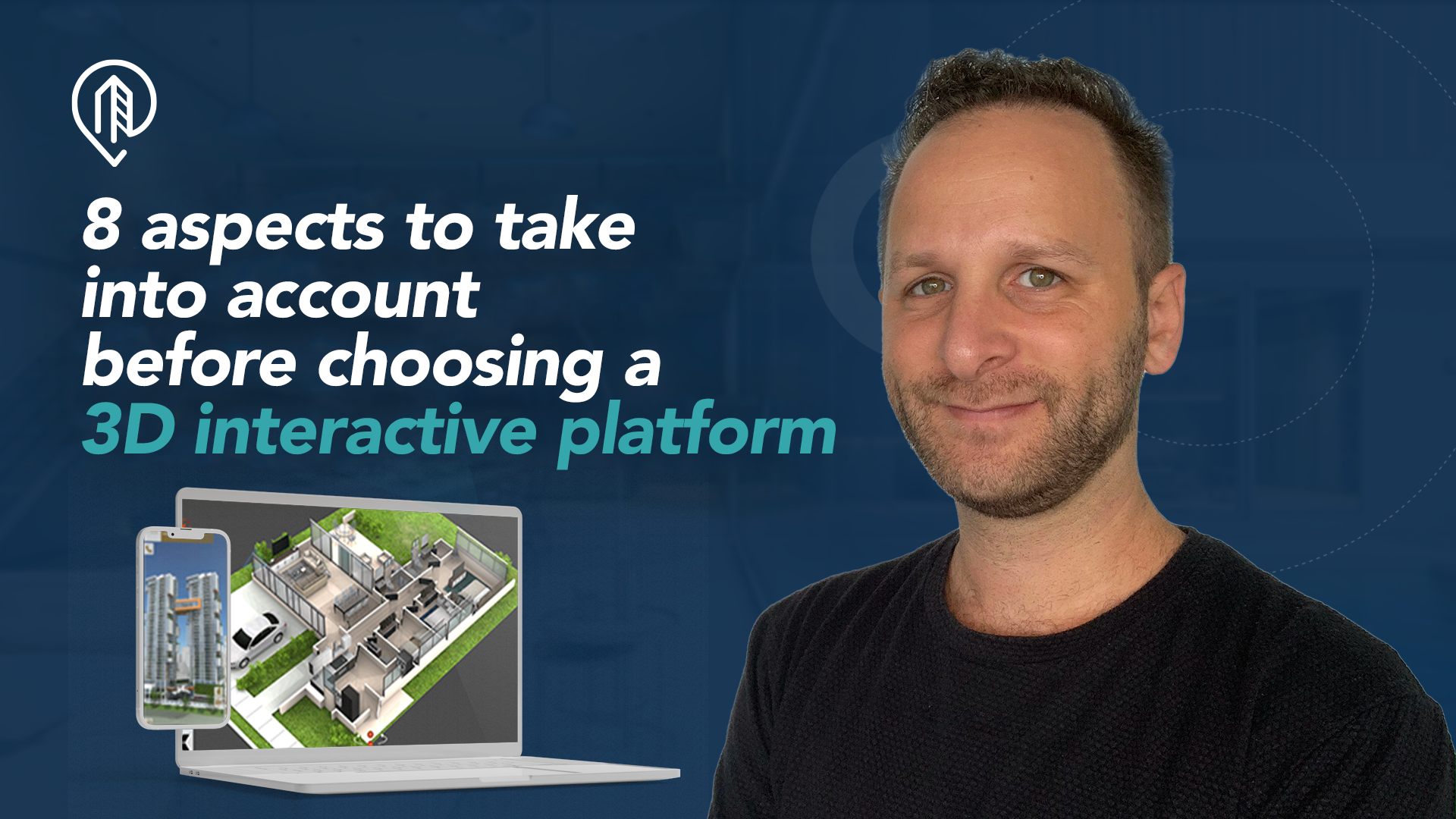It is normal, proptech continues to grow and with so many solutions for the real estate industry, it is difficult to choose the one that fits your needs.
There are several solutions to present and sell real estate projects in pre-sale. In this post we will tell you the differences and what you need to know to choose the ideal solution for you.
But, before choosing any solution, we must first understand the problem you want to solve.
Normally, most of the times we ask a real estate developer this, the answer is “I want to sell more.”
Logically, all companies in the world want to sell more, but, let me tell you that technology does not work magic, because the key to success is the combination of technology with your marketing and sales strategy and how you get your team to get the most out of it.
Proptech solutions help to achieve different goals, such as: increase productivity, improve the property buying experience, capture more leads…
The consequence of achieving these goals will be reflected in sales.
Asking yourself these questions can help you understand what do you want to solve:
- I want to generate more Leads
- I want to qualify Leads
- I want to generate awareness, that is, position my brand in front of my buyer persona.
- I want to generate Engagement with buyers, that is, achieve a “WoW” experience and make them fall in love with my project “quickly”.
- Where will I use this solution? In the showroom, on the web, on mobile devices?
- Who will use such a solution, the sales and/or marketing team. and buyers too?
- I want to increase the conversion rate in sales (on those who visited my project on the web, for example)
There are several possible goals, so we suggest you talk to your sales and marketing team and analyze your needs in order to understand what you are looking for in a solution for real estate pre-sales.
Now, before choosing an Interactive 3D Platform for your new Real Estate Development, we suggest you consider the following points:
1. REAL-TIME USER EXPERIENCE AND INTERACTIVITY
This question is key to understanding what kind of solution you are looking for.
If you have decided to purchase an Interactive 3D Sales Solution, you probably want your buyers to enjoy the best possible experience.
And here we will enter a little into the technicalities of the 3D virtual world.
- Is it an interactive solution?
- Is it a real-time 3D interactive solution or is it a solution based on 2D static images, i.e. renderings or JPG drone views?
Many solutions appear to be the same to the naked eye, but they are not.
Interactive 2D solutions are based on images, for example renderings, where the image quality is very high but the interaction between the user and the spaces is lost.
Otherwise, a real-time interactive 3D solution allows the user to explore the entire project from the outside to the inside, achieving an immersive experience, that is, rotating, zooming and visualizing each space as if the buyer were there in person.
Now, it is also true that there are solutions that only allow you to explore the outside (that is, the buildings) in 3D, but there are others that allow you to explore it completely, from each of the towers of the project to each of the apartments or houses of the masterplan, as well as the amenities, lobby, parking, etc etc.
2. COMPATIBILITY WITH VARIOUS DEVICES
On which devices does the solution work? ios? Android? Windows? Web browsers?
Many interactive solutions are based on 3D video games and therefore use software such as Unity or Unreal that require spectacular hardware to run them, so much so that you will have many difficulties to open them in web browsers.
We are in the era of mobile and the web, so choosing a solution that only works in the showroom (with Windows) can be harmful (except that’s what you’re looking for!).
Today real estate developers are looking for the buyer to have the project at their fingertips, therefore, make sure that the platform is compatible with all mobile devices and that it works smoothly on the web, respecting the graphic quality that your project deserves.
Just in case, ask if there are extra costs for the solution to work on each platform/device or if multi-device compatibility is 100% covered within the agreed budget.
We recommend you pay full attention to this, because you do not want a solution that is “limited” in these aspects.
3. OFFLINE AND ONLINE MODE
Does the solution work offline and online? That is, can I use the software on the web and can I also install the application natively on my devices?
This is extremely important, because we have seen developers who participate in real estate fairs where the Wifi signal is very limited and therefore if the solution only works with the internet, they can not use it.
It is also important to understand that your sales team will use this solution and it is usually much more comfortable and efficient to have it installed on their devices natively, on iOS, Android and Windows at the time of teaching the project.
In addition, native apps for mobile devices and PCs tend to have better load performance, fluidity and graphic quality compared to the web.
4. CONTENT DEVELOPMENT AND UPDATES
The development times of an interactive 3D solution depend a lot on the complexity of the project, its size, number of typologies, amenities… It will not be the same to develop a masterplan project with 5 towers than a single building of 50 apartments.
The important thing at this point is to foresee what are the estimated times that will take to develop your project, because you will want to make sure that you have everything ready for the launch of your project in pre-sale.
We have seen developers opting for solutions, usually based on 3D video games and end up waiting up to 6 months for the platform to be delivered. That’s too long!
On the other hand, it is important to understand what the deliverables will be partially in order to see progress. You should make sure there is a dedicated Project Management team where you can schedule meetings to review progress. This point is not minor!
Now, what about design changes? It is not news that the vast majority of real estate projects undergo changes in architectural design even after they have been launched into pre-sale.
Let’s imagine the following situation… Your architecture team has already finished the architectural design and you have in your hands the Autocad files of the project. What you most want to do now is to launch yourself into pre-sale, because in this first stage is when you will discover the real acceptance of the market.
You choose an interactive 3D solution for the pre-sale of your project. You pay for this solution, they give you the tool with all the 3D content and the pre-sale begins. Boom!
After a few weeks, the market gives you indications that the product you have designed is not ideal for this target, for example, you need to reduce the footage of the units and therefore decide to re-design the architectural plants.
Just as your architecture team must redo the Autocad or Revit files, so too will the company you hired for the interactive solution have to re-design the 3D content.
The problem is… What are the costs of such changes and how long do they take to make?
We suggest you ask these questions to your supplier before hiring them, because you will not like to be halfway because the costs of making changes to the 3D design and production times are highly excessive, especially when the solution you hired does NOT own the software and uses 3D video game software such as Unity or Unreal.
5. TYPES OF PROJECTS
Ask them if they carry out all kinds of projects: Vertical, Horizontal, Masterplan of several towers…
Is there a maximum capacity in number of total towers/units that the software supports?
Do you develop commercial office projects? Industrial projects?
The first thing is to make sure that the solution is 100% compatible with the type of project you develop.
On the other hand, it is important to mention that 3D content is heavier than the content of a web page, therefore, it is normal for some interactive 3D solutions to focus on having a balance between graphic quality and fluidity to obtain the best possible performance on the web.
Of course, if the software is installed on a Windows desktop computer, having the highest graphic quality in the 3D content would not be a problem, but when you try to have the same result on a mobile device or on the web, it is a challenge and becomes complicated, especially if the company does NOT own the software and uses 3D video game engines such as Unity or Unreal Engine.
In our experience, we’ve seen solutions that span all types of projects, but we’ve also seen some that only work for small projects of up to 100 units or just vertical projects.
This usually occurs when the provider is a company that does NOT specialize in real estate or its software is not optimized for 3D architecture.
6. INTEGRATIONS WITH OTHER APPS
What are the integrations that this solution has that you are evaluating?
Surely in your day to day you use Excel for your inventory, a CRM or an ERP or perhaps lead capture forms via web…
We live in the age of integrations where many of these applications interconnect with each other to facilitate our daily work, improve productivity and make our “life” easier.
In addition to these aspects, integrations serve to “avoid inconsistency” of data when you manage different applications that “use” or share the same data.
We have seen dozens of developers who hire a solution and then realize that it is NOT compatible with the applications or software that they themselves use daily and therefore end up doing the “double” work, here and there.
One of the most important integrations is that of inventory. If your inventory (prices / availability) is hosted in a real estate CRM and in parallel you use an interactive 3D solution that allows you to visualize the availability of each of the apartments, because the integration between both platforms will make your life easier and save a lot of time.
The price and status of real estate units are very changing data, so since both apps are integrated, you will NOT need to have a person dedicated to updating them 24×7.
This is one of the most relevant possible integrations, but also the capture and integration of generated Leads or the sending of a quote with the format you use in your CRM.
7. TECHNICAL SUPPORT AND CUSTOMER SUCCESS
Is there a dedicated support team?
If the solution you want to hire belongs to a software company, they should have a dedicated team to help you in any technical aspect of the tool.
If, on the other hand, you are thinking of hiring a marketing agency or a visualization services company, be sure to ask them this question. Often when we are users of a technology and for some reason we do not know how to use a particular feature or we have a technical problem of configuration or installation, the first thing we want to do is contact someone to help us solve it and as quickly as possible, because in the end, this could affect us in our daily sales.
Ask them what channels they use to provide support: Phone? Chat? Email? Do you have a help desk? How quick are they to answer?
Additionally, ask them: Is there a customer success team to provide after-sales support?
We often see real estate developers hiring technology solutions from companies that lack after-sales support…
It’s simple: Imagine you hired a solution, paid thousands of dollars for it, they give it to you. Then what’s next?
The objective of a customer success team is that you and your sales team can get the most out of the tool in the shortest possible time, this includes initial training to the sales force, continuous monitoring, communication of news and features that the company has developed and, in short, customer success is a concrete point of contact on which you can support yourself, give your feedback and suggestions for improvement.
Customer success is constantly concerned with collecting customer feedback to continue innovating and improving the solution and this translates into benefit for all customers, including you.
Without a customer success team, it’s as if no one listens to what you have to say or say about the solution.
Be sure to ask the provider if they have a customer success service and what its real functions are.
8. COMPANY BACKGROUND
Having these concepts clear, you already know what you want and surely evaluate different interactive solutions.
So, this point has to do with the experience of the company providing the solution.
- How many years of experience does the company offering the solution have? Do they own the software or use software from other companies? (Ask them if their solution is based on Unity, Unreal or what 3D technology they use? )
- Who are their customers? How many customers do they have? In which countries?
- How many projects developed? Which “emblematic” or recognized projects?
- Do they specialize in solutions for real estate pre-sales / leasing or do they have various types of solutions for various industries?
We hope these questions will help you choose the solution that best suits your needs and you can get the most out of it to push those sales!
If you need support in your next project, contact our advisors here!






